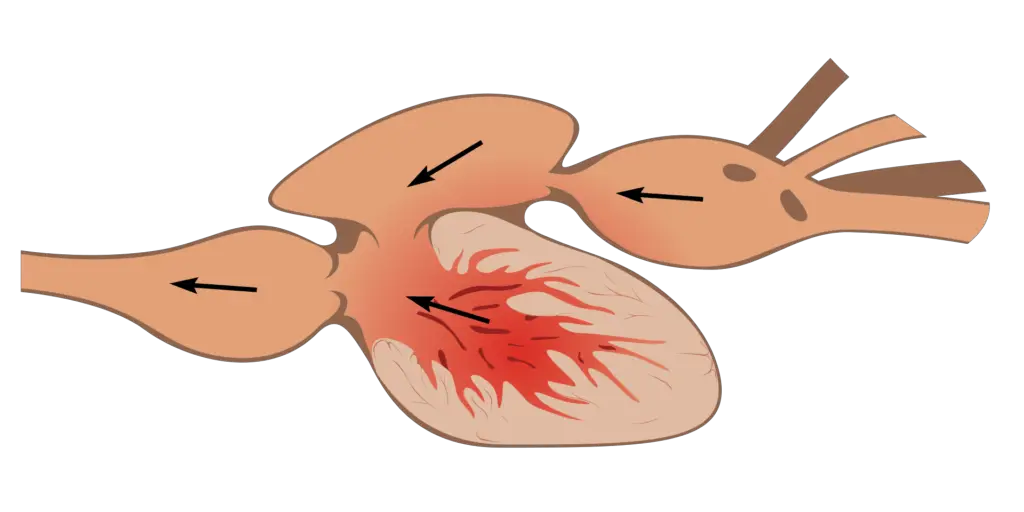Table of Contents
What is Human Circulatory System?
- The intricate architecture of the human body necessitates a multitude of physiological processes for its optimal functioning. Central to these processes is the delivery of indispensable elements to various body regions and the concurrent removal of metabolic by-products. This pivotal transportation task is executed by the human circulatory system.
- The circulatory system, a sophisticated network comprising arteries, veins, and capillaries, functions as the body’s internal transport mechanism. At the heart of this system lies the cardiac organ, responsible for propelling blood throughout this vast network. The primary objective of the circulatory system is the distribution of vital nutrients, minerals, and hormones to diverse body regions. Concurrently, it plays an instrumental role in gathering metabolic waste and toxins from cells and tissues, directing them towards purification or expulsion pathways.
- Scientifically delineated, the blood circulatory system encompasses a set of organs, notably the heart, blood vessels, and the circulating blood itself. This system can be categorized into two primary divisions: the systemic circulation and the pulmonary circulation. While some scientific literature might use the terms “cardiovascular system” and “vascular system” synonymously with the circulatory system, it’s imperative to understand the nuanced differences.
- The vast vessel network includes prominent heart vessels, expansive elastic arteries, and large veins, in addition to other arteries, diminutive arterioles, and capillaries that merge with venules. Notably, in vertebrates, the circulatory system operates as a closed entity, ensuring blood remains within the vessel network. Contrastingly, certain invertebrates, such as arthropods, exhibit an open circulatory system, while entities like sponges and comb jellies are devoid of a circulatory system altogether.
- Blood, a vital fluid, is composed of plasma, red and white blood cells, and platelets. It serves as the primary medium for transporting oxygen, nutrients, and waste products. The constituents of blood, including proteins, minerals, gases like oxygen and carbon dioxide, hormones, and hemoglobin, play crucial roles in nourishment, immune defense, and homeostatic regulation.
- In vertebrates, the circulatory system is complemented by the lymphatic system, which transports excess plasma filtered from capillaries as interstitial fluid. This fluid, termed lymph, takes a prolonged route to rejoin the blood circulation. The lymphatic system, often considered a secondary circulatory system, is integral to the circulatory system’s functionality, ensuring fluid balance. Furthermore, it collaborates closely with the immune system.
- However, the circulatory system is not impervious to ailments. Numerous cardiovascular diseases can compromise its efficiency. Medical specialists in this domain include cardiologists, who focus on heart-related issues, cardiothoracic surgeons who operate on the heart and surrounding regions, and vascular surgeons who address disorders of the blood and lymphatic vessels.

Definition of Human Circulatory System
The human circulatory system is a complex network of blood vessels, including arteries, veins, and capillaries, driven by the heart, responsible for transporting nutrients, oxygen, hormones, and waste products throughout the body.
Features of Circulatory System
The human circulatory system, a cornerstone of physiological functionality, boasts several distinctive features that underscore its significance in maintaining bodily homeostasis. These features are delineated as follows:
- Components: The circulatory system is an amalgamation of the heart, blood, blood vessels, and lymph. Each component plays a pivotal role in ensuring the efficient transportation of substances throughout the body.
- Double Circulation: Unique to the human circulatory system is its mechanism of double circulation. This entails two distinct loops: one dedicated to the circulation of oxygen-rich blood and the other to the circulation of oxygen-depleted blood.
- Cardiac Structure: The human heart, the system’s muscular pump, is compartmentalized into four chambers. These include two ventricles, responsible for pumping blood out of the heart, and two auricles (or atria), which receive blood returning to the heart.
- Vascular Network: The circulatory system is characterized by an extensive network of blood vessels, encompassing arteries, veins, and capillaries. Arteries transport oxygenated blood away from the heart, veins carry deoxygenated blood back to the heart, and capillaries facilitate the exchange of gases, nutrients, and waste products between blood and tissues.
- Functional Role: The primary objective of the circulatory system is twofold. Firstly, it ensures the delivery of oxygen and essential nutrients to every cell and tissue in the body. Secondly, it plays a crucial role in the collection and expulsion of metabolic waste products, thereby aiding in detoxification.
- Vascular Extent: A remarkable aspect of the circulatory system, often overlooked in standard diagrams, is its vast expanse. The cumulative length of the human body’s veins, arteries, and capillaries, if aligned consecutively, would approximate a staggering 1,00,000 kilometres. This is tantamount to encircling the Earth’s diameter approximately eight times.
In summation, the human circulatory system, with its intricate design and multifaceted functionality, stands as a testament to the marvels of physiological engineering.
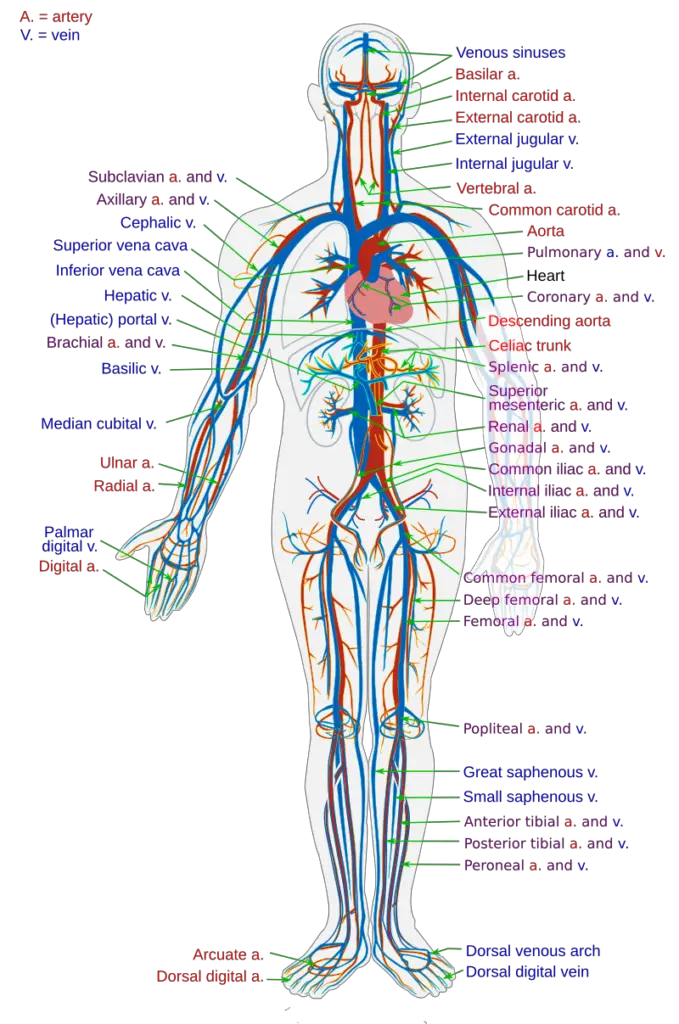
Structure of Circulatory System
The human circulatory system, a marvel of physiological engineering, is a composite structure designed to facilitate the efficient transportation of blood throughout the body. This system’s intricate architecture is delineated as follows:
- Primary Components: At its core, the circulatory system encompasses the heart, blood vessels, and blood. Each of these components plays a pivotal role in ensuring the optimal functioning of the system.
- Cardiovascular System: In all vertebrates, the cardiovascular system is constituted by the heart and an extensive network of blood vessels. This system is instrumental in ensuring the circulation of blood to and from various body regions.
- Circulatory Circuits:
- Pulmonary Circulation: This circuit originates from the right side of the heart, directing deoxygenated blood to the lungs. Here, the blood is oxygenated and subsequently returned to the left side of the heart.
- Systemic Circulation: This circuit facilitates the delivery of oxygen-rich blood from the left heart to the entirety of the body. Post delivering oxygen, the deoxygenated blood is channeled back to the right heart via prominent veins termed the venae cavae. The systemic circulation can be further bifurcated into:
- Macrocirculation: Pertains to the larger blood vessels.
- Microcirculation: Involves the smaller blood vessels, ensuring nutrients reach the organs via the intricate capillary network.
- Blood Volume: An average adult’s circulatory system holds approximately 4.7 to 5.7 liters of blood, which equates to nearly 7% of their total body mass. This blood is a composite of plasma, red and white blood cells, and platelets.
- Interplay with the Digestive System: The circulatory system collaborates closely with the digestive system, deriving essential nutrients to sustain cardiac functionality.
- Specialized Circulatory Routes: The circulatory system also encompasses specialized routes catering to specific organs. These include the coronary circulation (heart), cerebral circulation (brain), renal circulation (kidneys), and bronchial circulation (lungs).
- Closed System: The human circulatory system operates as a closed entity, ensuring blood remains confined within the vascular network. This design facilitates the efficient delivery of nutrients via the microcirculation’s minute blood vessels to various organs.
- Lymphatic Subsystem: Integral to the circulatory system is the lymphatic system, comprising lymphatic vessels, nodes, organs, tissues, and circulating lymph. Unlike the closed circulatory system, the lymphatic system operates as an open system. Its primary functions include transporting lymph, draining excess interstitial fluid, and collaborating with the immune system to offer protection against pathogens.
In summation, the human circulatory system, with its multifaceted structure and functionality, stands as a testament to the body’s intricate design and physiological prowess.
Organs of Circulatory System
The human circulatory system, a marvel of physiological design, is orchestrated by a set of primary organs, each contributing to the system’s overarching functionality. These organs, integral to the circulatory system’s operations, are elucidated as follows:
- Heart: Positioned centrally within the thoracic cavity, the heart serves as the circulatory system’s muscular pump. It is responsible for propelling blood throughout the body, ensuring the delivery of oxygen and nutrients to tissues and the removal of waste products. The heart’s rhythmic contractions and relaxations facilitate the circulation of blood through the vast network of blood vessels.
- Blood: While traditionally classified as a tissue, blood plays a role so pivotal that it is often referenced alongside the primary organs of the circulatory system. Comprising plasma, red blood cells, white blood cells, and platelets, blood is the medium through which oxygen, nutrients, hormones, and waste products are transported throughout the body.
- Blood Vessels: This extensive network of tubular structures is categorized into three primary types: arteries, veins, and capillaries. Arteries are responsible for carrying oxygen-rich blood away from the heart to the body’s tissues. In contrast, veins transport oxygen-depleted blood back to the heart. Capillaries, the smallest of the blood vessels, facilitate the exchange of gases, nutrients, and waste products between the blood and the body’s cells.
- Lymphatic System: Often considered a subsidiary yet vital component of the circulatory system, the lymphatic system comprises a network of lymph vessels, lymph nodes, and associated organs. Its primary function is to transport lymph, a clear fluid containing white blood cells, throughout the body. This system plays a crucial role in maintaining fluid balance, filtering harmful substances, and supporting the immune system.
In essence, the organs of the circulatory system, through their coordinated actions, ensure the efficient transportation and exchange of vital substances, thereby sustaining the body’s physiological equilibrium.
Heart
Situated within the thoracic cavity, the heart is a robust muscular organ nestled between the lungs, with a slight inclination towards the left. Encased by the pericardium, this vital organ serves as the linchpin of the circulatory system, ensuring the efficient transportation of blood throughout the body.
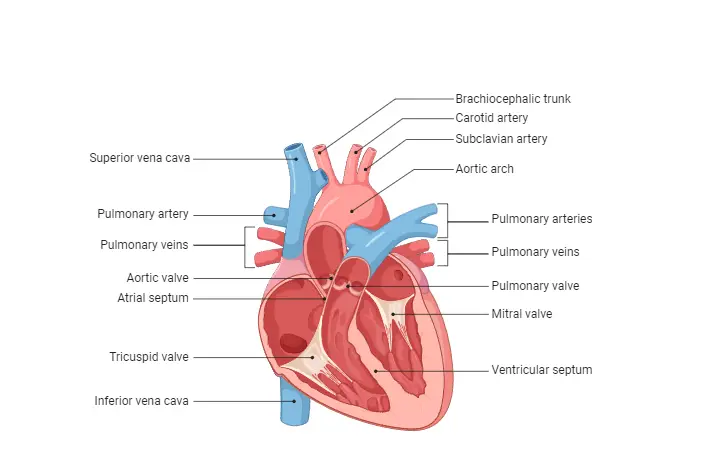
Chambered Structure: The human heart is compartmentalized into four distinct chambers. The upper two chambers are termed atria (singular: atrium), while the lower two are known as ventricles. This quad-chambered configuration is pivotal for the heart’s dual circulatory function. Specifically, the heart comprises the left atrium, left ventricle, right atrium, and right ventricle.
Functional Dynamics:
- Pulmonary Circulation: This circulatory route commences at the right atrium, which receives oxygen-depleted blood from the body via the superior and inferior vena cava. This deoxygenated blood traverses the tricuspid valve to enter the right ventricle. Subsequently, it is propelled into the pulmonary artery, leading to the lungs. Within the lungs, a critical gas exchange ensues: carbon dioxide is expelled from the blood, and oxygen is assimilated. The rejuvenated, oxygen-rich blood then returns to the heart, entering the left atrium via the pulmonary vein.
- Systemic Circulation: Originating from the left atrium, the oxygen-saturated blood is channeled into the left ventricle. From here, it is thrust into the aorta, initiating its journey to nourish the entirety of the body. Post delivering oxygen and nutrients, the now deoxygenated blood is collected and returned to the heart’s right atrium via two primary veins: the superior vena cava and the inferior vena cava. This circuit, encompassing both macrocirculation (larger blood vessels) and microcirculation (smaller blood vessels), ensures the efficient delivery and return of blood.
While the heart’s fundamental structure and function are conserved across vertebrates, there are notable variations in the circulatory systems of different species. For instance, the human circulatory system exhibits a higher degree of evolution and complexity compared to certain invertebrates like insects or molluscs.
In essence, the heart, with its intricate design and dual circulatory routes, stands as a testament to the body’s physiological prowess, ensuring the sustenance of life through the ceaseless delivery and purification of blood.
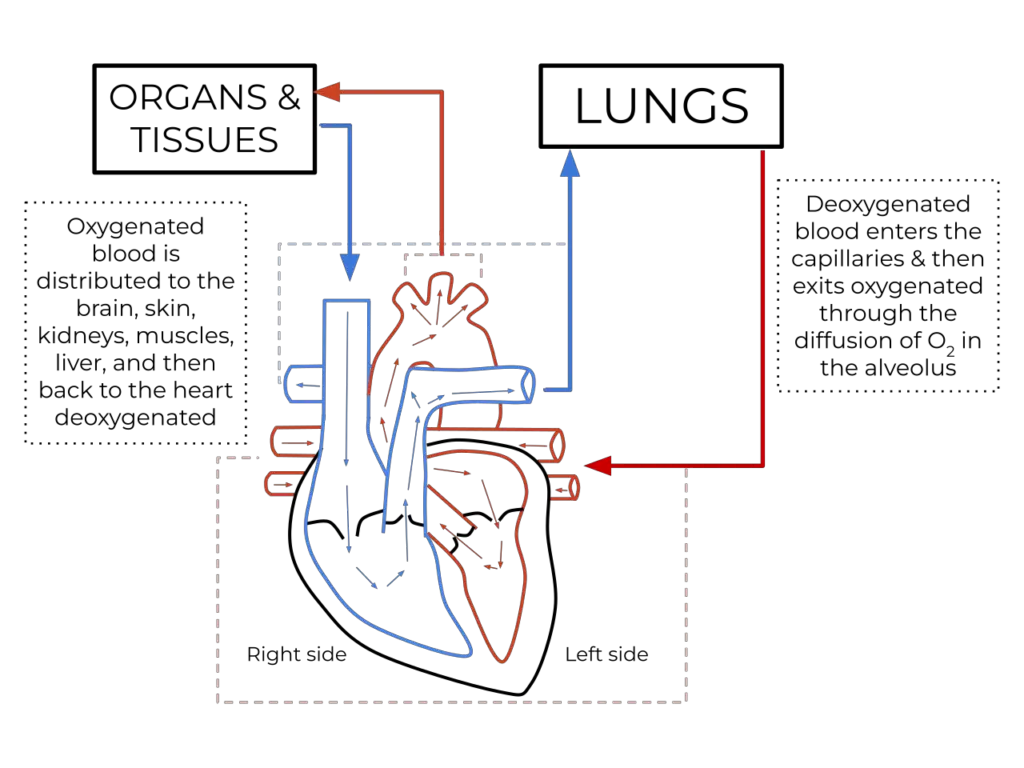
Double Circulation
- In the realm of human physiology, the circulatory mechanism stands out for its distinctive and efficient design. Termed “double circulation,” this system ensures that blood traverses the heart twice during a single complete circuit throughout the body.
- Contrastingly, certain species, such as fish, exhibit a “single circulation” system. In this model, blood navigates through the organism’s entirety just once in a singular circuit.
- The primary merit of the double circulation system lies in its ability to consistently deliver oxygen-rich blood to every tissue. This ensures that all bodily cells receive the requisite oxygen and nutrients for optimal function. Furthermore, this system meticulously segregates oxygenated and deoxygenated blood, preventing any potential admixture. Such a design not only enhances the efficiency of oxygen delivery but also ensures the effective removal of waste products.
- In summation, the double circulation system epitomizes the evolutionary sophistication of human cardiovascular physiology, ensuring a sustained and segregated flow of blood for optimal bodily function.
Blood
Blood, a quintessential component of the human circulatory system, is classified as the body’s fluid connective tissue. It plays an instrumental role in the transportation of vital substances, ensuring that nutrients, hormones, minerals, and other essential components are efficiently delivered to various regions of the body. The heart, a muscular organ, is responsible for propelling this vital fluid through a dedicated network known as blood vessels.
Composition of Blood:
- Plasma: Constituting the liquid matrix of blood, plasma is primarily composed of water, accounting for approximately 90% of its volume. This fluid medium facilitates the suspension and transport of the cellular and molecular components within the blood.
- Cellular Components: The solid fraction of blood comprises three primary cell types:
- Red Blood Cells (RBCs) or Erythrocytes: These biconcave cells are primarily tasked with the transportation of oxygen and nutrients to tissues and organs. Concurrently, they assist in the removal of metabolic waste products, ensuring cellular homeostasis.
- White Blood Cells (WBCs) or Leukocytes: Serving as the vanguard of the body’s immune system, WBCs are specialized cells that provide defense against foreign invaders, including pathogens and detrimental microorganisms. Their primary function is to safeguard the body from infections and diseases.
- Platelets or Thrombocytes: These small, disc-shaped cells play a pivotal role in hemostasis. Upon encountering a breach in the vascular system, such as a wound or injury, platelets swiftly aggregate at the site, initiating the clotting process to curtail bleeding.
In essence, blood is not merely a fluid but a dynamic tissue that performs a plethora of functions, from nourishing cells to defending the body against external threats. Its intricate composition and functionality underscore its significance in maintaining the physiological equilibrium of the human body.
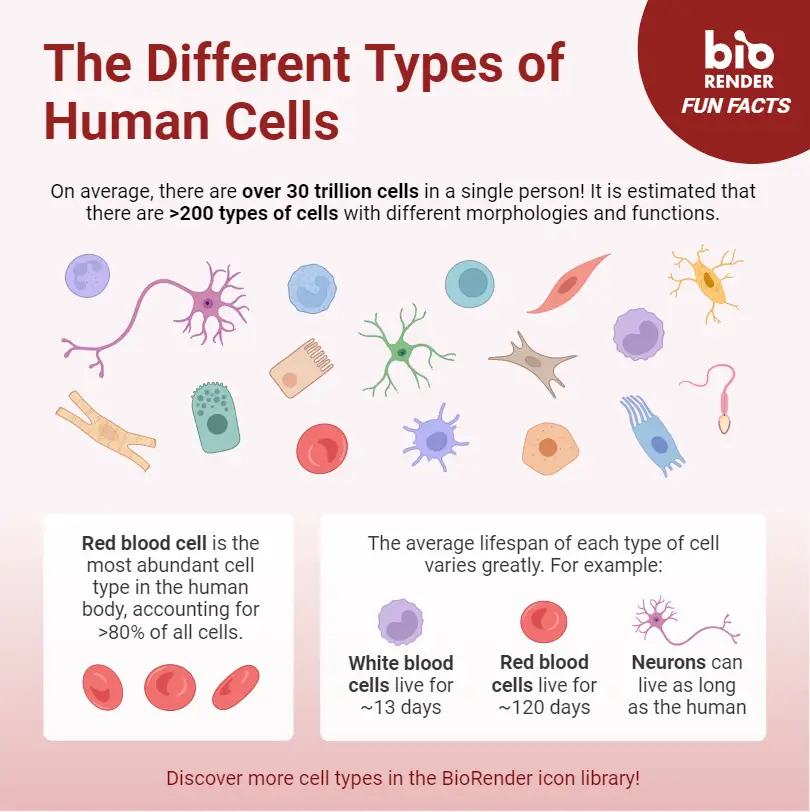
Types of Blood Cells
These cells can be broadly categorized into three distinct types, each with its unique structure and function:
1. Red Blood Cells (RBCs) or Erythrocytes: Erythrocytes, commonly referred to as Red Blood Cells (RBCs), are the most abundant cell type in human blood. Their primary function is to facilitate the transport of oxygen from the lungs to the body’s tissues and ferry carbon dioxide, a metabolic waste product, from the tissues to the lungs for exhalation. Structurally, RBCs are biconcave discs that contain hemoglobin, a protein that binds to oxygen. This unique shape increases their surface area, optimizing oxygen exchange. Additionally, RBCs play a role in nutrient delivery and waste removal, ensuring that cells receive essential nutrients for metabolic processes and concurrently expelling metabolic by-products.
2. White Blood Cells (WBCs) or Leukocytes: Leukocytes, known as White Blood Cells (WBCs), are the sentinels of the immune system. Unlike RBCs, they are fewer in number but are pivotal in safeguarding the body against infectious agents and foreign invaders. WBCs can be further sub-divided based on their morphology and function. They actively seek out and neutralize pathogens, including bacteria, viruses, and other harmful microorganisms. By doing so, they play a central role in the body’s defense mechanisms, ensuring that infections are contained and eliminated.
3. Platelets or Thrombocytes: Thrombocytes, commonly termed as platelets, are small, disc-shaped cell fragments that play a crucial role in hemostasis, the process by which bleeding is halted. When a blood vessel is injured, platelets rapidly adhere to the site of injury, aggregating to form a temporary “platelet plug.” They also release chemicals that initiate the clotting cascade, resulting in the formation of a stable fibrin clot. This clotting mechanism ensures that blood loss is minimized and provides a framework for tissue repair.
In summary, the diverse types of blood cells – erythrocytes, leukocytes, and thrombocytes – each serve distinct yet interconnected roles. Together, they ensure efficient oxygen and nutrient delivery, robust immune defense, and rapid response to vascular injury, thereby maintaining the body’s overall health and vitality.
Functions of Blood Cells
Blood cells play a pivotal role in maintaining the body’s physiological balance and overall health. Each type of blood cell has specific functions that contribute to the body’s homeostasis. Here’s a detailed breakdown of the functions of the primary blood cells:
1. Red Blood Cells (RBCs) or Erythrocytes:
- Oxygen Transport: RBCs contain hemoglobin, a protein that binds to oxygen in the lungs and delivers it to tissues throughout the body.
- Carbon Dioxide Removal: After delivering oxygen, RBCs pick up carbon dioxide, a waste product of cellular metabolism, and transport it back to the lungs for exhalation.
- Acid-Base Balance: RBCs help maintain the body’s pH balance by carrying carbon dioxide (in the form of bicarbonate) to the lungs and by buffering the blood with hemoglobin.
2. White Blood Cells (WBCs) or Leukocytes:
- Immune Defense: WBCs are the primary defenders against pathogens, including bacteria, viruses, and other foreign invaders.
- Phagocytosis: Some WBCs, like neutrophils and macrophages, engulf and digest pathogens in a process called phagocytosis.
- Antibody Production: Lymphocytes, a type of WBC, produce antibodies that target specific pathogens, ensuring a rapid response to future infections.
- Inflammation Regulation: WBCs release chemicals that promote or reduce inflammation, a key component of the body’s immune response.
- Allergic Reactions: Certain WBCs, such as eosinophils and basophils, play roles in allergic reactions and asthma.
3. Platelets or Thrombocytes:
- Blood Clotting: Upon vascular injury, platelets adhere to the site and release chemicals that initiate the clotting cascade, leading to the formation of a stable fibrin clot.
- Wound Healing: Platelets release growth factors that promote tissue repair and regeneration at the site of injury.
- Inflammation Modulation: Platelets can release chemicals that influence the inflammatory response, either amplifying or dampening it based on the body’s needs.
Together, these blood cells work in harmony to ensure efficient oxygen and nutrient delivery, robust immune responses, and rapid healing after injury. Their coordinated actions are essential for the body’s survival and overall well-being.
Blood Vessels
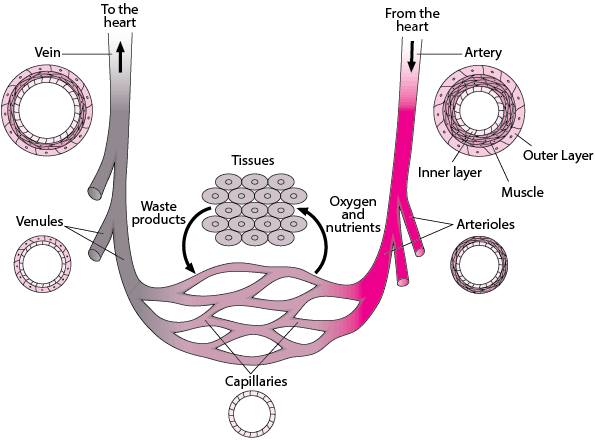
Blood vessels serve as the intricate network of pathways that facilitate the transport of blood throughout the human body, ensuring that every cell receives the essential nutrients and oxygen it requires. These vessels are categorized into three primary types, each with its distinct structure and function:
1. Arteries: Arteries are robust vessels designed to transport oxygen-enriched blood from the heart to various bodily tissues. Their walls, composed of thick muscular layers, are adept at withstanding the high pressure exerted by the heart’s contractions. The aorta stands as the most prominent artery, branching out to form a myriad of smaller arteries that permeate the entire body. Further branching leads to the formation of arterioles, which play a pivotal role in directing blood flow to specific organs.
2. Veins: In contrast to arteries, veins are tasked with carrying deoxygenated blood from the body’s peripheries back to the heart. Their walls are comparatively thinner, and they employ a combination of muscular contractions and specialized valves to facilitate the upward movement of blood against gravity. The vena cava, the body’s principal vein, bifurcates into two primary branches, each responsible for collecting blood from either the upper or lower half of the body.
3. Capillaries: Acting as the bridge between arteries and veins, capillaries are the tiniest blood vessels, characterized by their ultra-thin walls. Their minuscule diameter necessitates that red blood cells traverse them in a single-file manner. Distributed extensively throughout the body, capillaries form a vast network that seamlessly connects arterioles to venules. Their primary function is to facilitate the exchange of gases, nutrients, and waste products between blood and the surrounding tissues.
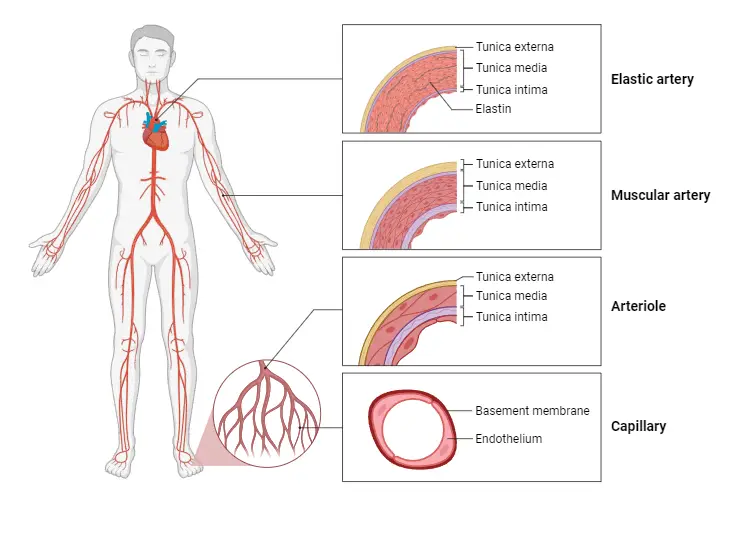
Functional Overview of Blood Vessels
Each type of blood vessel has specific functions tailored to its structure and location. Here’s a detailed breakdown of the functions of the primary blood vessels:
1. Arteries:
- Oxygenated Blood Transport: With the exception of the pulmonary artery, arteries carry oxygen-rich blood from the heart to various tissues and organs.
- Pressure Maintenance: The elastic walls of arteries help maintain blood pressure by expanding and contracting in response to the heart’s pumping action.
- Pulse Conduction: The pulsatile nature of blood flow, resulting from the heart’s contractions, can be felt in the arteries, especially those close to the skin’s surface.
2. Arterioles:
- Blood Flow Regulation: Arterioles control the amount of blood that flows into the capillaries by constricting or dilating. This regulation is crucial for maintaining blood pressure and directing blood to tissues based on their needs.
- Resistance Provision: Arterioles offer resistance to blood flow, which is essential for maintaining systemic blood pressure.
3. Capillaries:
- Nutrient and Gas Exchange: Capillaries facilitate the exchange of oxygen, nutrients, and waste products between the blood and body tissues.
- Heat Regulation: Blood flow in the capillaries can help regulate body temperature by redistributing heat.
4. Venules:
- Collecting Blood: Venules collect deoxygenated blood from capillaries and channel it into larger veins.
- Immune Response: Some venules, particularly postcapillary venules, are sites where white blood cells can exit the bloodstream and enter tissues in response to infection or inflammation.
5. Veins:
- Deoxygenated Blood Transport: With the exception of the pulmonary veins, veins carry deoxygenated blood from the body’s tissues and organs back to the heart.
- Blood Reservoir: Veins can expand and hold a large volume of blood, acting as a reservoir that can be mobilized when needed.
- Valve Containment: Veins, especially those in the limbs, contain valves that prevent the backward flow of blood, ensuring unidirectional flow towards the heart.
In summary, blood vessels play a crucial role in maintaining the body’s physiological balance. They ensure efficient delivery of oxygen and nutrients, removal of waste products, and regulation of blood flow and pressure, among other vital functions.
The circulatory dynamics are driven by the heart’s rhythmic contractions, propelling blood with force through the arteries. As blood journeys through capillaries, essential exchanges occur at the cellular level. The return journey, facilitated by veins, relies on the combined action of surrounding muscle contractions and the presence of valves to prevent backflow. This perpetual cycle of blood movement is indispensable for sustaining life and ensuring the optimal functioning of the body’s myriad systems.
Lymphatic System
The Lymphatic System stands as a crucial subsystem of the Circulatory System, playing an indispensable role in fluid homeostasis and bolstering the body’s immune defenses. This system is an intricate assembly of Lymphatic vessels, Lymph nodes, and specialized Lymphoid organs, including the spleen and thymus gland.
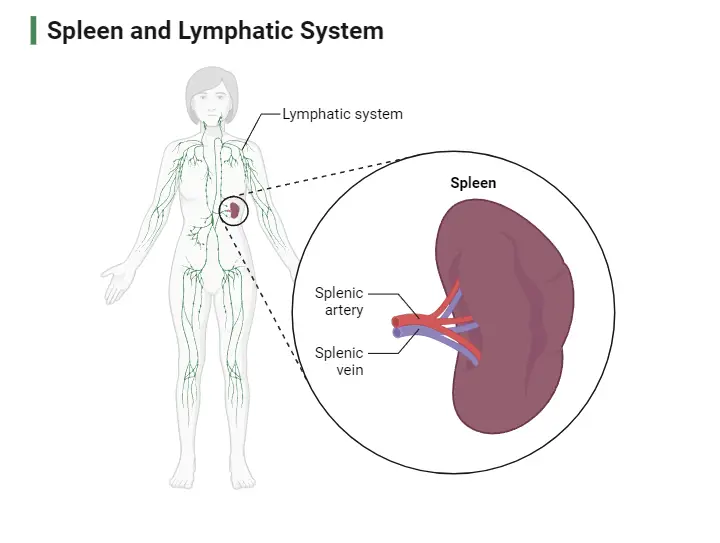
1. Lymphatic Vessels: These are delicate, web-like channels that permeate the body, mirroring the distribution of blood vessels. Their primary function is to transport lymph, a translucent fluid enriched with white blood cells, proteins, and lipids. Lymph originates from the interstitial fluid that bathes our cells, collecting the surplus fluid that escapes from the blood vessels. The Lymphatic vessels then channel this fluid back into the bloodstream, ensuring a balanced fluid environment within the body.
2. Lymph Nodes: Scattered throughout the body are small, kidney bean-shaped structures known as Lymph nodes. Typically clustered in groups, these nodes act as filtration stations for the lymph. As the lymph courses through them, harmful entities like bacteria, viruses, and even malignant cells are trapped and neutralized. Furthermore, these nodes house immune cells that can recognize and mount a defense against foreign invaders, thereby activating the body’s immune response.
3. Lymphoid Organs: The spleen and thymus gland are primary Lymphoid organs. The spleen filters the blood, removing aged blood cells and foreign particles, while also serving as a reservoir for platelets. The thymus, on the other hand, is pivotal during early life, aiding in the maturation of a specific type of white blood cell, the T-lymphocyte.
In synergy with the Circulatory System, the Lymphatic System ensures the body’s immune system operates at its peak. By shuttling white blood cells to Lymph nodes, it facilitates the rapid detection and neutralization of harmful agents that might breach the body’s defenses. Additionally, the Lymphatic System plays a pivotal role in the digestive realm, absorbing dietary fats and ferrying them to the bloodstream, where they can be metabolized and harnessed for energy. In essence, the Lymphatic System is a guardian and regulator, ensuring both protection from external threats and internal fluid equilibrium.
Functions of Lymphatic System
The lymphatic system is a complex network of vessels, nodes, and organs that plays several vital roles in maintaining the health and stability of the body. Here are the primary functions of the lymphatic system:
1. Fluid Balance Maintenance:
- The lymphatic system collects and returns excess interstitial fluid (fluid that surrounds the body’s cells) to the bloodstream, ensuring a balance of fluid levels in the body’s tissues.
2. Fat Absorption:
- The lacteals, specialized lymph vessels located in the lining of the small intestine, absorb dietary fats and transport them to the bloodstream.
3. Immune System Support:
- Lymphocyte Production: Lymph nodes and other lymphatic organs produce and store cells (lymphocytes) that fight infection and disease.
- Filtration: Lymph nodes act as filters, trapping foreign particles, bacteria, viruses, and other pathogens, preventing them from entering the bloodstream.
- Antigen Presentation: The lymphatic system exposes pathogens to immune cells, facilitating the activation of the immune response.
4. Waste Removal:
- The lymphatic system collects and transports waste products and toxins away from tissues, eventually returning them to the bloodstream for elimination.
5. Protein Transport:
- Proteins that escape from the bloodstream into the interstitial spaces are returned to the blood via the lymphatic system, preventing protein buildup in the tissues.
6. Circulation of Lymph:
- Unlike blood, which is pumped by the heart, lymph is moved through its vessels primarily by the contraction of surrounding muscles. Valves in the lymphatic vessels prevent backflow, ensuring unidirectional movement of lymph towards the heart.
7. Immune Surveillance:
- The lymphatic system continually monitors the body for pathogens, damaged cells, or cancer cells. When detected, it initiates an immune response to address the threat.
In essence, the lymphatic system is crucial for maintaining fluid balance, absorbing dietary fats, supporting the immune system, and removing waste from the body. It works in tandem with other systems to ensure the body’s optimal functioning and defense against disease.
How the Circulatory System Works ?
Here’s an overview of how this intricate system functions:
- Initiation at the Heart: The heart, a central organ in the circulatory system, first receives deoxygenated and nutrient-depleted blood from the body through two primary veins: the superior vena cava and the inferior vena cava.
- Transition through the Right Chambers: This incoming blood is directed into the right atrium. Upon contraction of the right atrium, the blood is channeled into the right ventricle.
- Pulmonary Circulation: The right ventricle, upon contraction, propels the blood into the pulmonary artery, which leads it to the lungs.
- Oxygenation in the Lungs: Within the lungs, a vital gas exchange occurs. Blood relinquishes carbon dioxide and absorbs oxygen, transforming from a deoxygenated state to an oxygen-rich one.
- Entry into the Left Chambers: The newly oxygenated blood is then transported from the lungs via the pulmonary vein into the left atrium. Subsequent contraction of the left atrium pushes this blood into the left ventricle.
- Systemic Circulation Initiation: The left ventricle, upon contracting, drives the oxygenated blood into the aorta, the body’s principal artery.
- Distribution to the Body: The aorta subsequently divides into numerous smaller arteries, which further branch out, ensuring the delivery of oxygen and essential nutrients to every part of the body.
- Exchange at the Capillaries: As these arteries culminate in capillaries, the oxygen and nutrients carried by the blood are released to nourish cells and tissues. Simultaneously, capillaries absorb carbon dioxide and other waste products.
- Return Journey via Veins: Post this exchange, the now deoxygenated blood, laden with waste products, begins its return journey. It first enters tiny veins known as venules, which subsequently merge into larger veins.
- Completing the Cycle: These veins channel the deoxygenated blood back to the heart, marking the completion of one circulatory cycle and the commencement of the next.
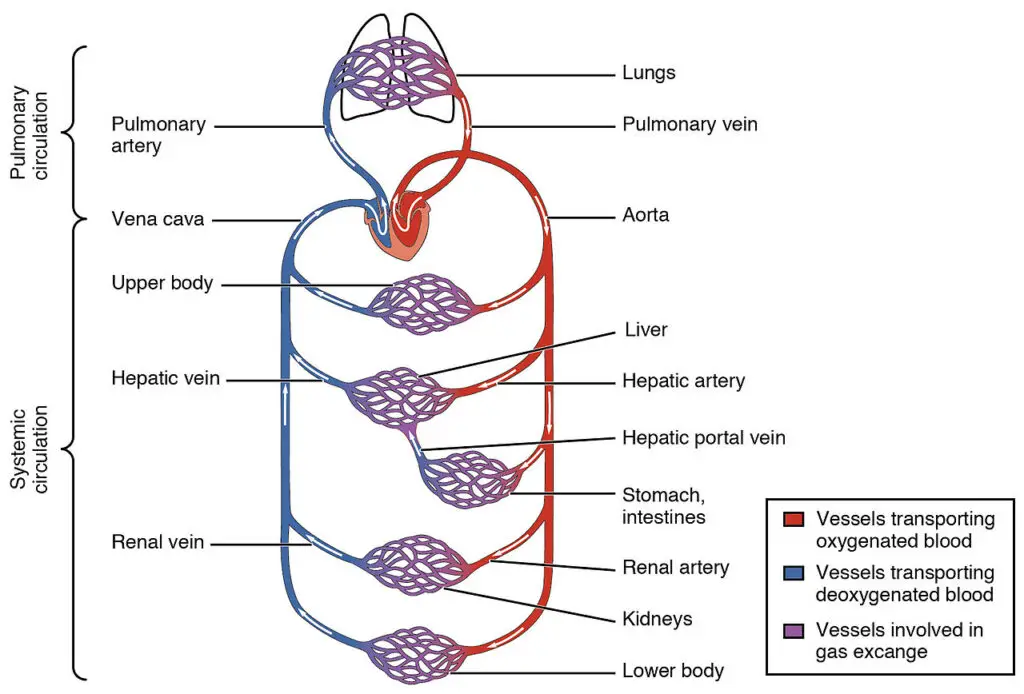
In essence, the circulatory system operates as a continuous loop, ensuring that every cell in the body receives the oxygen and nutrients it requires while simultaneously facilitating the removal of waste products.
Development of Circulatory System
The circulatory system’s genesis is a meticulously orchestrated process that commences during the embryonic phase. This intricate system, responsible for transporting nutrients, oxygen, and waste products throughout the body, undergoes a series of developmental stages to achieve its final form.
Vasculogenesis and Early Development
The inception of the circulatory system is marked by vasculogenesis in the embryo. During this phase, the arterial and venous systems emerge from distinct embryonic regions. Specifically, the arterial system primarily evolves from the aortic arches, a series of six paired arches located in the embryo’s upper portion. In contrast, the venous system originates from three bilateral veins between the 4th and 8th weeks of embryogenesis.
Fetal Circulation
By the 8th week, fetal circulation is established. Notably, this circulation bypasses the lungs, utilizing the truncus arteriosus instead. The fetus derives its oxygen and nutrients from the mother, facilitated by the placenta and the umbilical cord.
Arterial System Development
The arterial system’s foundation is laid by the aortic arches and the dorsal aortae. While the first two aortic arches regress, giving rise to the maxillary and stapedial arteries, the arterial system predominantly arises from the 3rd, 4th, and 6th aortic arches. The dorsal aortae, initially present bilaterally, eventually merge, forming the aorta’s precursor. This aorta subsequently gives rise to numerous smaller arteries, including the intercostal, lumbar, lateral sacral, and arteries of the limbs. Additionally, lateral branches evolve into the renal, suprarenal, and gonadal arteries. Anterior branches of the aorta, namely the vitelline and umbilical arteries, metamorphose into the gastrointestinal tract’s celiac, superior, and inferior mesenteric arteries. Post-birth, the umbilical arteries transform into the internal iliac arteries.
Venous System Development
The venous system’s genesis is primarily attributed to the vitelline veins, umbilical veins, and cardinal veins, all converging into the sinus venosus. The vitelline veins are particularly instrumental in forming the gastrointestinal tract’s venous system.
In summary, the development of the human circulatory system is a complex, multi-stage process that begins in the embryonic phase and undergoes numerous transformations to achieve its mature form, ensuring efficient blood flow and nutrient distribution throughout the body.
Circulatory System of Other animals
The circulatory system, a vital component in many organisms, exhibits a range of complexities and variations across the animal kingdom. While vertebrates, including humans, possess a closed circulatory system, certain invertebrates operate with an open system. The evolution and adaptation of these systems reflect the diverse needs and environments of these organisms.
Open Circulatory System: In organisms like arthropods, an open circulatory system prevails, where the fluid, termed hemolymph, directly bathes the organs. This system lacks a clear distinction between blood and interstitial fluid. The movement of the animal aids in the circulation of hemolymph, which fills the body’s interior hemocoel and surrounds all cells. Hemolymph comprises water, inorganic salts, and organic compounds. The primary oxygen transporter in this system is hemocyanin. Additionally, free-floating cells known as hemocytes are present in the hemolymph, playing a crucial role in the arthropod’s immune response.
Closed Circulatory System: Vertebrates, along with annelids and cephalopods, possess a closed circulatory system, where blood remains confined within the heart or blood vessels. This system has evolved in various stages across different species:
- Fish: Operate with a single circuit system, where blood is pumped through gill capillaries and then to body tissue capillaries. Their heart consists of two chambers.
- Amphibians: Exhibit a double circulatory system but with a three-chambered heart, not fully separating the two pumps.
- Reptiles: Possess an incomplete ventricular septum, allowing for an alternative blood flow route. This adaptation aids ectothermic animals in body temperature regulation.
- Mammals, Birds, and Crocodilians: Have a completely separated heart into two pumps, resulting in four heart chambers. This evolution in birds and crocodilians is believed to have occurred independently from mammals. The double circulatory system in these organisms allows for efficient oxygen delivery to tissues.
Absence of a Circulatory System: Certain animals, such as flatworms, lack a circulatory system altogether. Their body’s design facilitates direct diffusion of nutrients to all cells. Similarly, jellyfish possess an extensive branching from their gastrovascular cavity, enabling direct nutrient diffusion to outer layers.
In conclusion, the circulatory systems across various animal species showcase a myriad of adaptations and evolutionary paths. These systems, whether open, closed, or even absent, are tailored to the specific needs and environments of each organism, ensuring their survival and optimal functioning.
Functions of Circulatory System
The circulatory system, an intricate network of vessels, organs, and fluids, plays a pivotal role in maintaining the physiological equilibrium of the human body. Its primary and most crucial function is the transportation of oxygen to various tissues and organs, ensuring their optimal functionality. However, the circulatory system’s responsibilities extend beyond this primary role:
- Sustenance of Organ Systems: The circulatory system is instrumental in supporting and maintaining the vitality of all organ systems, ensuring their coordinated and harmonious operation.
- Transportation: Beyond oxygen, the circulatory system is responsible for the efficient transport of blood, essential nutrients, hormones, and carbon dioxide. This ensures that cells receive the necessary nutrients for their function while simultaneously facilitating the removal of waste products.
- Protection: The circulatory system plays a defensive role by shielding cells from potential threats, such as pathogens. Components within the blood, particularly white blood cells, actively combat and neutralize these foreign invaders, safeguarding the body’s health.
- Cell-to-Cell Interaction: The circulatory system serves as a conduit for cellular communication. Through various signaling molecules and mediators present in the blood, cells can interact, communicate, and coordinate their functions.
- Tissue Repair: The blood carries a plethora of substances, including growth factors and clotting agents, that aid in the repair and regeneration of damaged tissues. This ensures timely healing and restoration of tissue integrity.
- Thermoregulation: The circulatory system plays a crucial role in regulating the body’s temperature. Blood vessels can dilate or constrict to either dissipate or conserve heat, ensuring the body maintains an optimal internal temperature.
- pH Balance Maintenance: The blood within the circulatory system helps maintain a stable pH level in the body, ensuring that the internal environment remains conducive for enzymatic and cellular functions.
- Waste Removal: Apart from carbon dioxide, the circulatory system aids in transporting metabolic waste products to the kidneys, liver, and lungs for excretion, ensuring the body remains free from toxic build-up.
- Distribution of Immune Cells: The circulatory system facilitates the movement of immune cells, such as leukocytes and antibodies, ensuring rapid response to sites of infection or injury.
- Hormonal Distribution: Hormones released by endocrine glands are transported by the circulatory system to target organs and tissues, ensuring coordinated physiological responses.
- Clotting Mechanism Activation: In the event of an injury, the circulatory system activates the clotting mechanism, preventing excessive blood loss and initiating the healing process.
- Nutrient Absorption and Distribution: After digestion, nutrients like glucose, amino acids, and lipids are absorbed into the bloodstream and transported to cells and tissues for energy, growth, and repair.
- Shock Absorption: The circulatory system, particularly the veins, acts as a ‘shock absorber’, cushioning organs against trauma and preventing potential damage.
- Reservoir Function: Veins, especially the large ones like the venae cavae, act as reservoirs, storing blood that can be mobilized during increased demand, such as during physical exertion.
- Facilitation of Gas Exchange: In the lungs, the circulatory system facilitates the exchange of oxygen and carbon dioxide, ensuring cells receive fresh oxygen while expelling metabolic carbon dioxide.
In summary, the circulatory system is not merely a transportation network but a multifunctional system that ensures the body’s homeostasis, protection, and overall well-being.
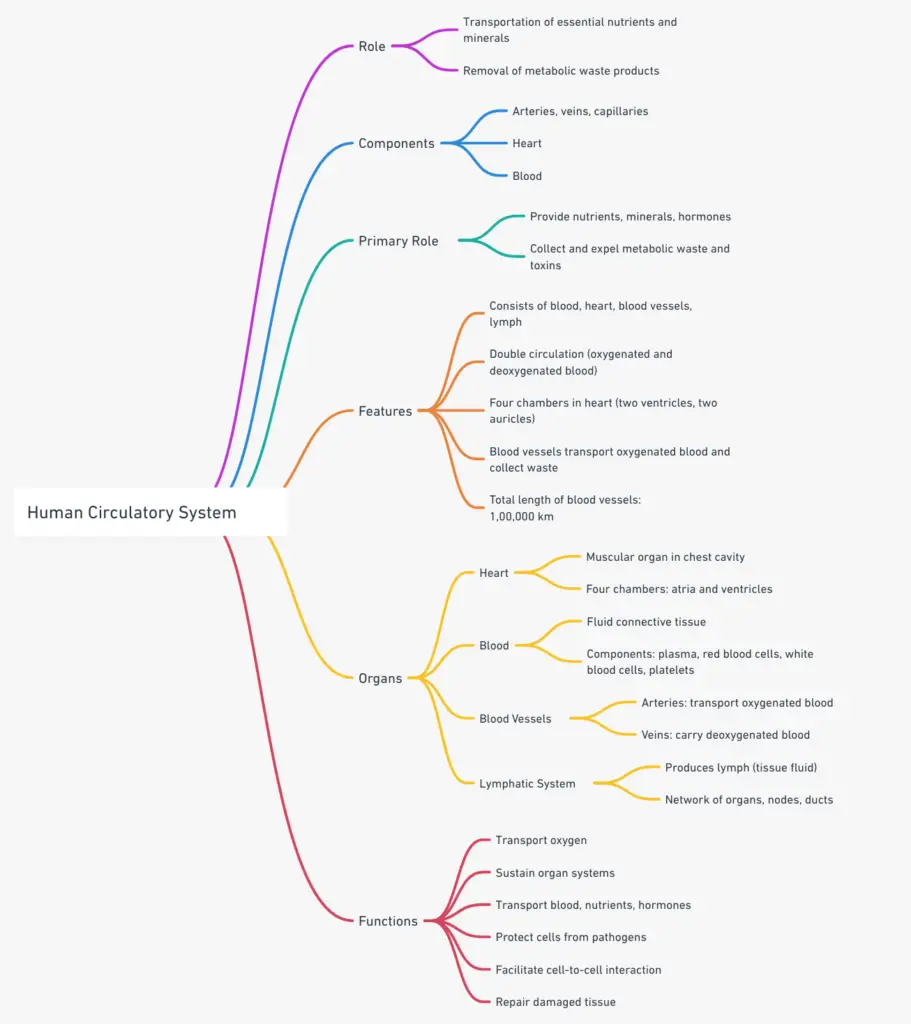
FAQ
What is the primary function of the circulatory system?
The main function of the circulatory system is to transport oxygen, nutrients, and hormones to cells throughout the body and remove waste products like carbon dioxide and metabolic byproducts.
What are the main components of the circulatory system?
The primary components include the heart, blood, and a network of blood vessels, which can be categorized into arteries, veins, and capillaries.
How does the heart pump blood throughout the body?
The heart has four chambers: two atria and two ventricles. The right side pumps deoxygenated blood to the lungs, and the left side pumps oxygenated blood to the rest of the body.
What is the difference between arteries and veins?
Arteries carry blood away from the heart, usually oxygen-rich, while veins carry blood back to the heart, typically oxygen-poor, except for the pulmonary veins.
What is the role of capillaries in the circulatory system?
Capillaries are tiny blood vessels where the exchange of oxygen, nutrients, and waste products occurs between the blood and surrounding tissues.
Why is the circulatory system often referred to as a “double circulation” system in mammals?
Because it has two distinct pathways: the pulmonary circulation (between the heart and lungs) and the systemic circulation (between the heart and the rest of the body).
How does the lymphatic system relate to the circulatory system?
The lymphatic system is an auxiliary system that returns excess interstitial fluid to the bloodstream and plays a vital role in immune defense.
What is blood pressure, and why is it crucial?
Blood pressure is the force exerted by the blood against the walls of the blood vessels. It ensures that blood circulates effectively throughout the body, delivering oxygen and nutrients to tissues.
How do lifestyle factors like diet and exercise impact the circulatory system?
A healthy diet and regular exercise can promote good cardiovascular health, reducing the risk of diseases like hypertension, atherosclerosis, and heart attacks.
What are some common disorders of the circulatory system?
Common disorders include hypertension (high blood pressure), coronary artery disease, heart attacks, strokes, and varicose veins.
References
- Cleveland Clinic. (2021). Circulatory System: Anatomy and Function. Retrieved from https://my.clevelandclinic.org/health/body/21775-circulatory-system.
- Encyclopedia Britannica. (2023). Circulatory system | Functions, Parts, & Facts. Retrieved from https://www.britannica.com/science/circulatory-system.
- Lovering, C. (2018). Understanding the Circulatory System and Its Major Components. Healthline. Retrieved from https://www.healthline.com/human-body-maps/circulatory-system.
- InformedHealth.org. (2019). How does the blood circulatory system work? Institute for Quality and Efficiency in Health Care (IQWiG). Retrieved from https://www.ncbi.nlm.nih.gov/books/NBK279250/.
- Better Health Channel. (n.d.). Circulatory system. State of Victoria. Retrieved from https://www.betterhealth.vic.gov.au/health/conditionsandtreatments/circulatory-system.
- Baum, H. (n.d.). The Circulatory System: The Body’s Transport System. University of Cincinnati. Retrieved from https://www.uc.edu/content/dam/uc/ce/docs/OLLI/Page%20Content/OLLI%20Circulatory_System.pdf.
- LibreTexts. (2022). 15.3A: Anatomy of Human Circulatory System. Retrieved from https://bio.libretexts.org/Bookshelves/Introductory_and_General_Biology/Biology_(Kimball)/15%3A_The_Anatomy_and_Physiology_of_Animals/15.03%3A_Circulatory_Systems/15.3A%3A_Anatomy_of_Human_Circulatory_System.
- Khan Academy. (2023). The circulatory system review. Retrieved from https://www.khanacademy.org/science/high-school-biology/hs-human-body-systems/hs-the-circulatory-and-respiratory-systems/a/hs-the-circulatory-system-review.
- Visible Body. (2023). Pulmonary Circulation and Systemic Circulation: The Routes and Function of Blood Flow. Retrieved from https://www.visiblebody.com/learn/circulatory/circulatory-pulmonary-systemic-circulation.
- British Heart Foundation. (2021). How your heart works. Retrieved from https://www.bhf.org.uk/informationsupport/how-a-healthy-heart-works.

